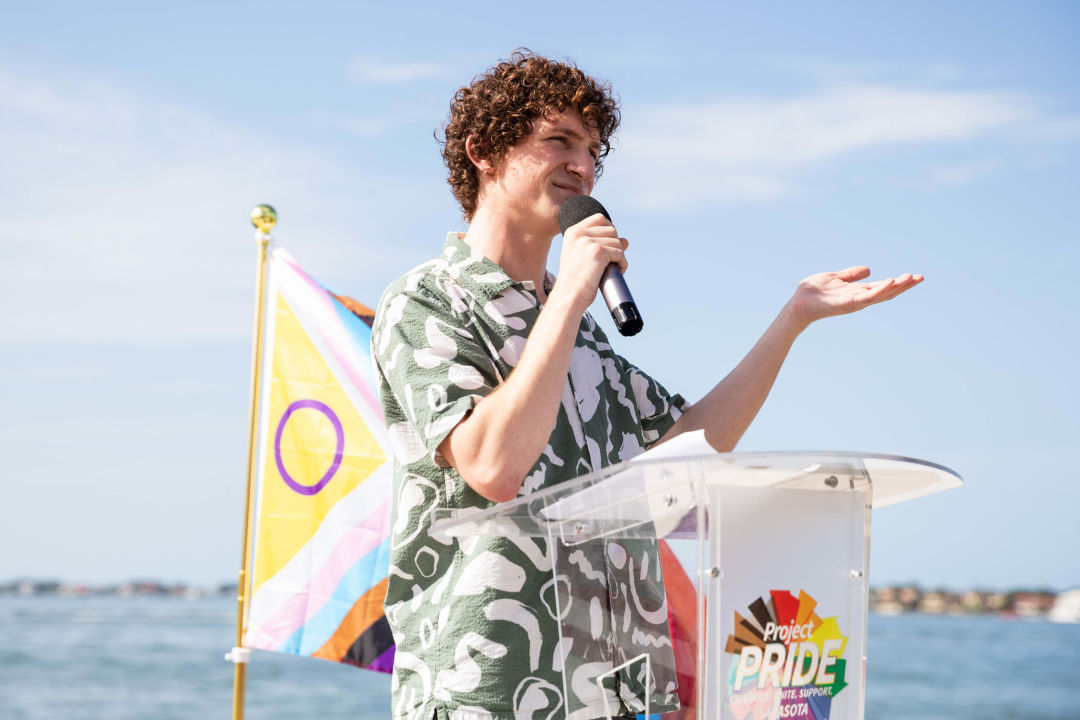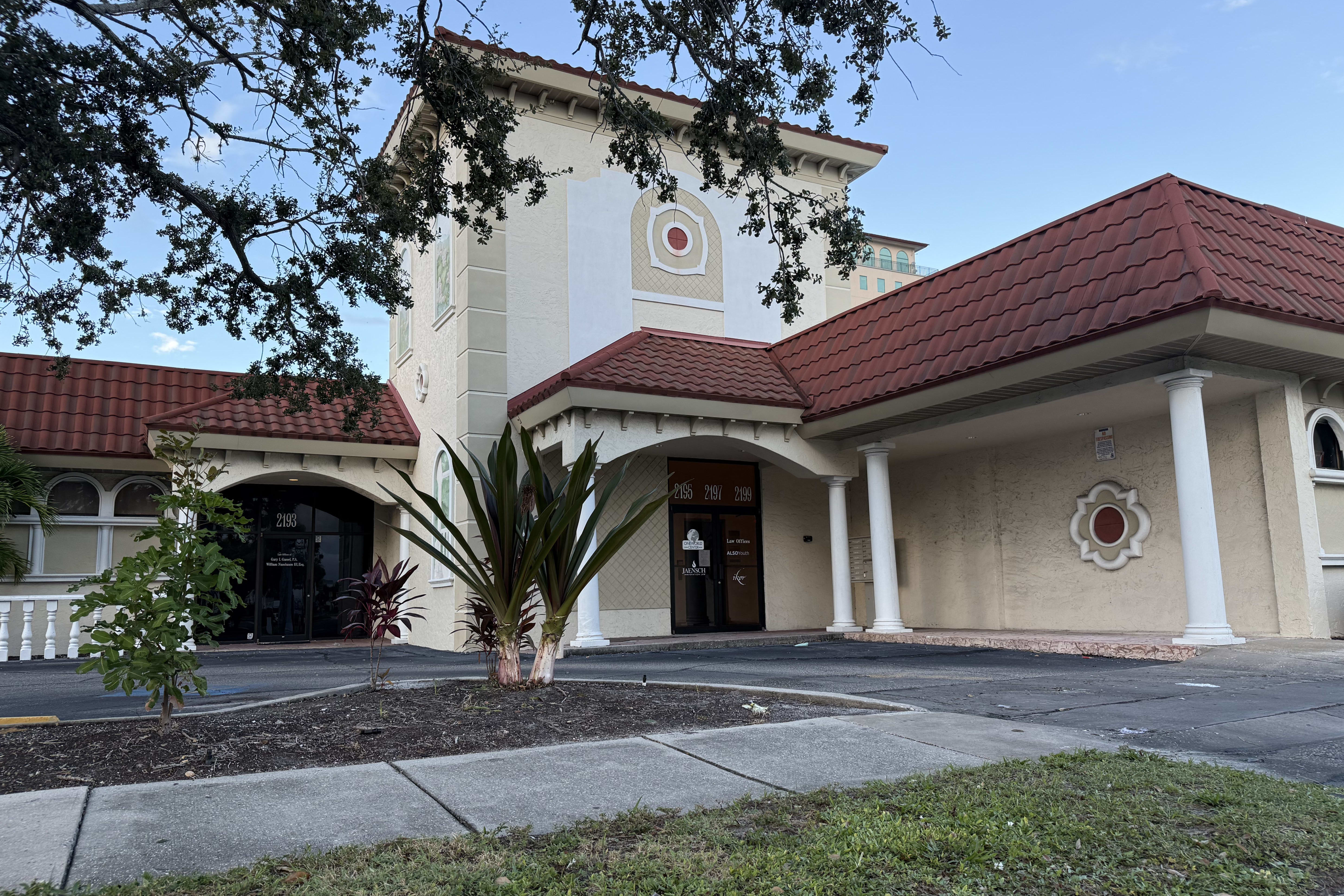The SEE Alliance Is Working to Mobilize Florida's Young Voters

Image: Hannah Phillips
Sarasota doesn’t seem like a likely place for a revolt led by Florida’s youth, and Burns Court even less so as the movement’s ground zero. At first glance, the SEE Space, the headquarters of the Social Equity Through Education Alliance, known as the SEE Alliance, could be just another building in an unremarkable stretch on Orange Avenue, but behind the front door, it’s the hub of an activist organization aimed at mobilizing Florida’s youth to vote, starting at the most local of levels: with public school board elections.
The unassuming exterior is partly by design. Step inside, and you'll find a vibrant interior bedecked with a purple neon sign, hanging plants and a graffiti-ed bathroom with notes like “Replace when empty” next to a bright green painted arrow below the toilet paper holder. It is the physical manifestation of a “safe space,” not obvious to those on the outside, but immediately welcoming to those who enter.
At the center of it all is Zander Moricz, the curly-haired Pine View School graduate taking a two-year academic pause from Harvard University. You may know Moricz from delivering a euphemistic valedictorian speech using “curly-haired” to mean, well, something else after the passage of Florida’s Parental Rights in Education law (dubbed the “Don’t Say Gay” bill by activists). He has also been a named plaintiff in a federal lawsuit challenging that legislation, and he participates in Sarasota County School Board meetings, criticizing Chair Bridget Ziegler, for example, for supporting policies against the LGBTQ+ community while engaging in same-sex relationships herself. The 20-year-old is a unique organizer who can both speak to his generation and communicate to the intergenerational masses. During our interview, he sometimes punctuates his carefully researched guidance with youthful remarks. When talking about an innovative app to get young people to register to vote, for example, he says, “It’s really a vibe.” It’s an example of the contradiction in being young and being a political organizer—having to be at once serious and relatable.
The SEE Alliance, which Moricz founded as a high school sophomore, is already fully funded for the duration of the 2024 election season. That’s thanks in large part to two $1 million grants from the Jonathan D + Mark C. Lewis Foundation, as well as big-ticket gifts from community donors.
Opening a physical space in downtown Sarasota was part of Moricz’s fundraising plan. While much is made of Gen Z being a fully digital generation, the history of activism shows the necessity of in-person organizing.
“The history of collective action—from artistic movements to political activism—is still one of in-person meetings in houses, in squats, in churches, in bars, in cafés, in parks,” wrote Jenny Odell in her 2019 book How to Do Nothing: Resisting the Attention Economy. “In these federated spaces of appearance, disagreements and debates were not triggers that shut the whole discussion down, but rather an integral part of group deliberation, and they played out in a field of mutual responsibility and respect.”
Whether Moricz knowingly draws on this legacy or not, he understands the value of a physical organizing space. To design it, he asked for input from young people who participated in last year’s statewide walkout and his followers on social media to make the environment feel crowd-sourced and not designed by one person. Those surveys revealed clear preferences for an outdoor space with an open flow in which one could walk around the entire complex without hitting a wall. Young people also had some more characteristic demands: a dining area and fairy lights, for starters, which posed some problems.
“Our director of operations, who is an adult, was like, ‘You cannot have fairy lights. It’s going to be a fire hazard. There’s absolutely no way,’” says Moricz. “But this is where intergenerational organizing comes in. Our DOO found a cost-efficient solution—LED fairy lights.”
The SEE Alliance’s work is aimed in one direction: the 2024 elections. Moricz opted to take a leave of absence from his sophomore year at Harvard to focus on building and staffing SEE, a decision he says he doesn’t take lightly.
“I would not leave Harvard if I thought this was a losing fight,” says Moricz. “The reason that this movement needed to be invested in now, and not a year from now, or two years from now, or when it’s convenient, is because the movement that is growing within Gen Z in Florida right now is monumental, unique to circumstance and cannot easily be recreated or reinvigorated later on.”
This is a generation, Moricz argues, that has experienced their formative years under the leadership of President Donald Trump and Florida Gov. Ron DeSantis, and that hears day in and day out that Florida is a lost cause politically.
“Florida has the most diverse youth population out of any state in the entire country and the most disenfranchised youth voter population in the entire country,” says Moricz. “Almost never are those two statistics talked about in the same sentence.”
A series of legislative measures have, in fact, made it harder for young people to register to vote and cast a ballot. A 2023 state law, for example, increased restrictions on third-party voter registration organizations, making it harder to register students to vote through college campus drives. And registration among 18-year-olds in Florida was already low. In 2022 in Broward County, only 30 percent of 18-year-olds were registered to vote, and in Miami-Dade County the portion was only 25 percent, according to The Civics Center.
Moricz says the solution is to start small—to bring young people into local elections that directly affect them, like school board races. In a presidential or gubernatorial election, it’s difficult for most voters to feel like their vote matters, but when voting for a school board member, the feeling of what Moricz calls “subconscious deference”—how can I vote on health care or property insurance or the military when, at my age, I can’t even imagine the impact?—no longer becomes an issue.
“The people making 90 percent of the choices in school board elections haven’t been in a public school in 20, 30, 40 years,” he tells young people. “You were in a public school last year.”
For Moricz, participating in school board elections can be a pathway toward mobilizing voters for the long haul. Once a young person begins voting in a local election, why would they not go ahead and vote in bigger races?
“This is going to be a school board accountability movement that turns into a school board voter registration movement that turns into a statewide youth electorate movement,” says Moricz.
Florida also has an important school board-related question for voters on its November ballot: Amendment 1, which would make school board elections partisan starting in November 2026. (The state’s school board elections have been technically nonpartisan since 1998, although party involvement in school board races is hardly uncommon.)
The SEE Alliance is also launching other projects, like UltraVote, a platform dedicated to helping young people register to vote. As part of the initiative, young people can send out an explanatory voter registration link to their friends as an Instagram direct message.
“The contact is something like 80 times better than phone calls, and it’s significantly better for reaching young people,” says Moricz. “When you have random calls, young people don’t answer, but when you have a D.M. from a friend, it resonates.”
According to Moricz, many national groups doing year-round youth organizing in Florida have left the state, assuming they will have little impact, although this narrative may be changing with the emergence of Vice President Kamala Harris as the Democratic presidential nominee, according to political journalists.
“Young Floridians are hungry for opportunities that allow them to channel their anger, pain and marginalization into action, especially opportunities that allow them to lead the way,” says Moricz. “We hear from many community members that organize with us that they’re not necessarily passionate about politics, but they care about Sarasota students and Florida’s students and aren’t comfortable with simply watching what’s being done to them.”
The evening before I spoke with Moricz, he and August Rey, who recently graduated from Sarasota High School, went to a Sarasota County School Board meeting and offered public comment after painstakingly preparing their speeches beforehand. It was Rey’s first time speaking at a meeting.
“I would never have gone there without having people that I knew had my back,” says Rey. “I needed to make sure my voice was heard. So many people like me want to say something but feel like they won’t be heard.”
Sara Suzuki is a senior researcher at Tufts University’s Center for Information and Research on Civic Learning and Engagement (known as CIRCLE). She notes that digital organizing tactics, including Q.R. codes and direct messages, tend to work best with young people, but they’re not a panacea.
“We know that young people still really closely follow local TV and local newspapers and use that as a source for political information,” she says. “This goes against this image of Gen Z having a fully social media-based diet for their information needs.”
In the course of CIRCLE’s research, a worrying trend has also emerged among young people engaged in political activism: They often suffer from poor mental health. According to Suzuki, one way this can be improved is through the creation of physical organizing spaces, which promotes improved mental health in a way that social media organizing cannot.
Roughly 58 percent of Florida registered voters are in the three youngest generations: Generation X, millennials and Gen Z. About 34 percent would be considered millennials or Gen Z, a slightly larger percentage than the portion of registered Baby Boomers in Florida, according to Susan MacManus, a professor emerita of political science at the University of South Florida and one of Florida’s leading political analysts. Younger voters are also more likely to not be registered with either major political party. Thirty-five percent of Gen Z voters and 33 percent of millennials are not registered with either major party, compared to just 20 percent of Boomers, according to data analyzed by Sayfie Review.
According to MacManus, issues trump parties for young voters, and there is perhaps no bigger issue for them than climate change. CIRCLE research shows a strong correlation between young people who report climate as a top issue and those who are extremely likely to vote.
But the way young voters are targeted around the issues that matter to them still leaves much to be desired, according to Suzuki. A pre-2024 election survey from CIRCLE shows that less than 20 percent of young people have been contacted by political organizations about voting.
“Less than one in five, for us at CIRCLE—that is a horrendous number,” says Suzuki. “The misconception here is that young people have the information but are disinterested or disengaged. What’s actually happening is that there is a lack of outreach and resources.”
“With the focus on young voters that SEE Alliance is going to be doing, it’s filling a gap,” says Suzuki. “It’s not a crowded space that they’re entering. There’s really this huge need for more contact and outreach to young people about politics and voting information.”
MacManus says today's political climate is "the most negative context we have seen in forever and a day. People are tremendously down on the government, big corporations and the media and politicians.”
The key for an organization like Moricz’s, MacManus says, is emphasizing state and local elections rather than focusing their efforts on the presidential vote. That’s already in line with how the SEE Alliance sees itself—as a Florida-headquartered group focused on mobilizing Florida’s youth, not the nation’s.
“As we grow, one day, the ideal outcome is for all Floridians to have autonomy over their bodies and futures, and for the SEE Alliance to work with the government, instead of against it, to better serve the people,” says Moricz. “The game plan is simple: If we have a free Florida, we have a free United States—period.”



